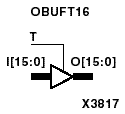| Element | XC3000 | XC4000E | XC4000X | XC5200 | XC9000 | Spartan | SpartanXL | Virtex |
|---|---|---|---|---|---|---|---|---|
| OBUFT | Primitive | Primitive | Primitive | Primitive | Primitive | Primitive | Primitive | Primitive |
| OBUFT4, OBUFT8, OBUFT16 | Macro | Macro | Macro | Macro | Macro | Macro | Macro | Macro |




OBUFT, OBUFT4, OBUFT8, and OBUFT16 are single and multiple 3-state output buffers with inputs I, I3 - I0, I7 - I0, I15 - I0, outputs O, O3 - O0, O7 - O0, O15 - O0, and active-Low output enables (T). When T is Low, data on the inputs of the buffers is transferred to the corresponding outputs. When T is High, the output is high impedance (off or Z state). OBUFTs isolate the internal circuit and provide extra drive current for signals leaving a chip. An OBUFT output is connected to an OPAD or an IOPAD.
For Virtex, refer to the “OBUFT_selectIO” section for information on OBUFT variants with selectable I/O interfaces. OBUFT, 4, 8, and 16 use the LVTTL standard. Also, Virtex OBUFT, 4, 8, and 16 have selectable drive and slew rates using the DRIVE and SLOW or FAST constraints. The defaults are DRIVE=12 mA and SLOW slew.
| Inputs | Outputs | |
|---|---|---|
| T | I | O |
| 1 | X | Z |
| 0 | 1 | 1 |
| 0 | 0 | 0 |
Figure 8.4 OBUFT8 Implementation XC3000, XC4000, XC5200, XC9000, Spartans, Virtex |